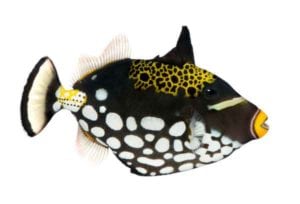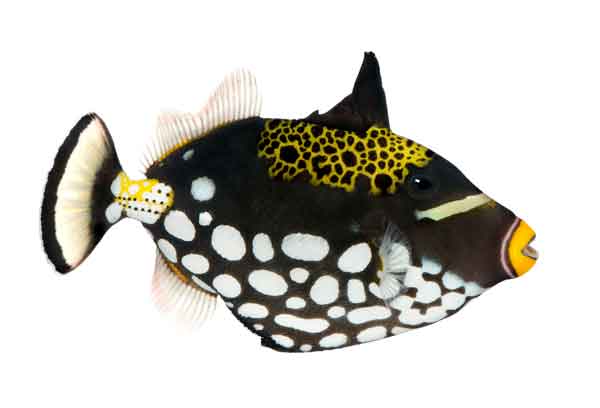Care Recommendations for the Clown Triggerfish (Balistoides conspicillum)
- Care Level: Easy
- Temperament: Aggressive
- Color Form: Black, Blue, Green, Orange, White, Yellow
- Diet: Carnivore
- Reef Compatible: No
- Water Conditions: 72-78° F, dKH 8-12, pH 8.1-8.4, sg 1.020-1.025
- Max. Size: 1′ 8″
- Origin: Australia, Indonesia, Sumatra
- Family: Balistidae
- Minimum Tank Size: 300 gallons
Clown Trigger Overview

This astonishing looking fish has a number of unrelated patterns on its body that make it look almost unreal but instantly recognizable. Be cautious, however, because this carnivore is known for its aggressive temperament toward other fish. Provide a large tank with plenty of room for this territorial fish. Once comfortable in a tank, this fish will often take food out of your hand. Feed with caution though, their teeth are sharp! Also be careful when placing rockwork in the tank. The Clown Trigger will move rocks to suit its needs.
Physical Characteristics of the Clown Triggerfish
Contrasting their black body are a number of white dots that look almost as if they had been painted on. Additionally, they have bold white stripes near the eyes and caudal fin, with white and yellow stripes outlining the mouth. Their patterns look almost tribal in nature. Just below the dorsal fin is a bright splash of yellow with a number of black dots within. It has the same look as a leopard’s spots, giving this fish a truly unique look.
The head is large, making up nearly a third of the total body with the eyes being sunken and proportionately small for the body. Despite being laterally compressed like many other fish found around reefs, the clown trigger has a large and bulky feel to it. The dorsal fin is made up of three spines, one of which is sharp and hidden among the others. It is mainly used to deter a potential rival or for defensive purposes.
Once fully grown, their teeth are extremely sharp as well. Aquarium keepers have noted that adult teeth have actually scratched the glass of the tank. Be careful with the amount of electrical wire attached to the pump that remains in the water–the ever curious Clown will eventually try to give a go at that as well.
The Clown’s appearance is only matched by its outsized personality. Many hobbyists find this fish not only curious but constantly engaging with its tank mates and people as well. It can be trained to follow you around the tank and even take food from your hand.
Tank Conditions for Clown Triggerfish
Triggers need a lot of swimming room so be sure to have a larger size tank. This should include plenty of rock work will small crevasses and caves that the fish will utilize when resting or feeling stressed.
As juveniles, the Clown Trigger is friendly and makes a good tank mate. This rarely lasts until adulthood and you should be aware of the fish developing aggressive and even belligerent behavior. Think about changing tanks or the other fish at this point. The Clown Trigger will look to eat anything it outsizes.
Make sure any excess food that may fall to the sand bed is shoveled out. This may mean you are feeding the fish too frequently or quickly for them to consume it all. The organic buildup can lead to a spike in nitrate and phosphate levels in the water and have a negative effect on Triggers in particular.
Diet & Nutrition for the Clown Triggerfish
This carnivore will subsist on a meaty diet of mysis shrimp, silversides and other meaty foods such as clams or mollusks. Occasionally, soak the food in garlic before feeding. This will help repel external parasites and boost immunity.
Read about other popular fish in the industry.
Learn more about caring for Triggerfish

















